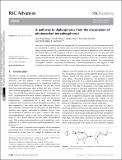A pathway to diphosphorus from the dissociation of photoexcited tetraphosphorus
Author(s)
Wang, Lee-Ping; Tofan, Daniel; Chen, Jiahao; Van Voorhis, Troy; Cummins, Christopher C.
DownloadCummins_A pathway to.pdf (947.3Kb)
PUBLISHER_CC
Publisher with Creative Commons License
Creative Commons Attribution
Terms of use
Metadata
Show full item recordAbstract
We report a computational study of an energetically favorable pathway for the excited-state dissociation of a tetrahedral P[subscript 4] molecule into two P[subscript 2] molecules via the simultaneous breaking of four chemical bonds along a highly symmetric (D[subscript 2d]) reaction pathway. Along this pathway, a degeneracy occurs between the first excited state of P[subscript 4] and the ground state of 2P[subscript 2] at a lower total energy (ca. 4.7 eV) than the initial state, indicating that the initial photoexcitation provides sufficient energy for the dissociation without significant kinetic barriers. We also found that sequential dissociation of the four P–P bonds exhibits larger activation barriers thus making this a less viable dissociation pathway. Our computational investigation uncovers complicated photochemistry in elemental phosphorus, and suggests a likely mechanism for the environmentally friendly inclusion of phosphorus atoms into organic molecules.
Date issued
2013-09Department
Massachusetts Institute of Technology. Computer Science and Artificial Intelligence Laboratory; Massachusetts Institute of Technology. Department of ChemistryJournal
RSC Advances
Publisher
Royal Society of Chemistry
Citation
Wang, Lee-Ping, Daniel Tofan, Jiahao Chen, Troy Van Voorhis, and Christopher C. Cummins. “A Pathway to Diphosphorus from the Dissociation of Photoexcited Tetraphosphorus.” RSC Adv. 3, no. 45 (2013): 23166. © The Royal Society of Chemistry
Version: Final published version
ISSN
2046-2069